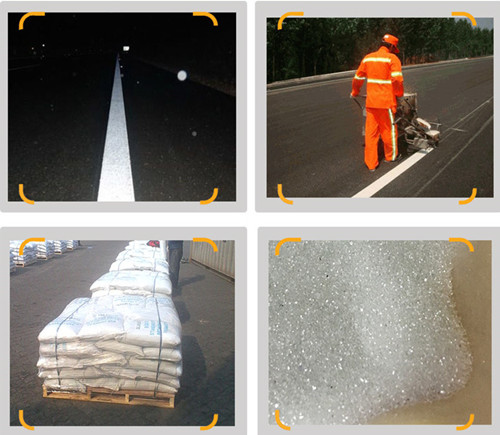EVALUATION OF RETROREFLECTIVITY
While other aspects of appearance and durability are important to determine the useful life of pavement markings, those markings are only useful if they can be seen in all conditions, especially at nighttime. Retrorefl ectivity testing has improved the performance of pavement markings. Retrorefl ectivity can be assessed either visually at night or by the use of retrorefl ectance meters such as the Mirolux-12, Ecolux, Gamma/ART Retrolux-1500, or the Delta LTL-2000. Currently in the United States, 15- and 30-meter geometry instruments, as well as mobile equipment technologies are used. The color of the pavement marking may affect the results of the retrorefl ective instruments. For example, if a non-leaded yellow paint line begins to deteriorate from UV radiation (i.e.- get lighter in color) but has no bead loss from the initial application, the refl ectometer values may increase. In summary, retrorefl ectivity and durability are a function of the following parameters: • The refractive index of the glass bead material • Gradation or size of the glass beads • Roundness of the beads • The coating on the beads • The embedment of the beads in the material • The distribution of glass beads in the pavement material • The number of exposed beads on the marking surface • The relationship between the diameter of the beads and the striping material thickness 2012 v1.0 2-15 The fi rst four items are controllable manufacturing items. These can be specifi ed and tested for minimum requirements. The last four items are related to the application of materials. Even if the fi rst four items are strictly adhered to, either a bad application of binder material or a bad application of beads will negate the quality of the ingredients and result in a non-durable and/or non-retrorefl ective pavement marking. NEW MATERIALS Advances in striping materials (i.e. higher solids, better reactive polymers, etc.) as well as advances in adherence type coatings on refl ective beads allow larger refl ective beads to be used. These larger refl ective beads provide better wet night retrorefl ective performance. Standard refl ective beads, as previously described, may have their retrorefl ectivity [turned off" by a thin fi lm of water. The new larger refl ective beads stick up above a water fi lm and continue to retrorefl ect headlights during rain. However, the larger beads are more susceptible to snow plow damage. Figure 2.19 is a troubleshooting guide for bead application problems.
Drop-on Glass Beads, during the process of road work, drop glass bead onto the road line painted with thermoplastic paint which is heated to certain temperature while the paint is still wet, thus to increase the reflectivity of road marking.
How Glass Beads are Applied to Pavement Marking Materials:
The glass beads are applied to pavement marking materials. They can be premixed in marking materials before application, or they can be dropped or sprayed into the wet paint directly behind the paint sprayer, or a portion can be dropped onto premixed two-part epoxy or thermoplastic materials.
The top surface of beads is enveloped by the paint, with the wicking action of the paint rising up to above the midpoint of the bead. This provides two actions. It locks the glass beads into the paint and allows the paint to act as a diffuse reflecting surface for retroreflection, with the paint color affecting the color of the retroreflected light. The light entering the glass bead is bent and focused towards the back of the bead and reflected back out towards the headlights and driver.

Drop-on Glass Beads
Thermoplastic Paint Drop-On Glass Beads,Traffic Paint Drop-on Glass Beads, Road Marking Drop-on Glass Beads, Reflective Drop-on Glass Beads
YONGQING BAILUYUAN GLASS PRODUCTS CO.,LTD , http://www.blyglassbeads.com